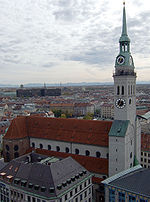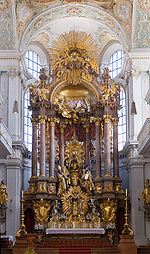
St. Peter's Church, München
Encyclopedia


Munich
Munich The city's motto is "" . Before 2006, it was "Weltstadt mit Herz" . Its native name, , is derived from the Old High German Munichen, meaning "by the monks' place". The city's name derives from the monks of the Benedictine order who founded the city; hence the monk depicted on the city's coat...
, southern Germany
Germany
Germany , officially the Federal Republic of Germany , is a federal parliamentary republic in Europe. The country consists of 16 states while the capital and largest city is Berlin. Germany covers an area of 357,021 km2 and has a largely temperate seasonal climate...
. It is also the oldest church in the district.
History
Before the foundation of Munich as a city in 1158, there had been a pre-Merovingian church on this site. 8th century monks lived around this church on a hill called Petersbergl. At the end of the 12th century a new church in the BavariaBavaria
Bavaria, formally the Free State of Bavaria is a state of Germany, located in the southeast of Germany. With an area of , it is the largest state by area, forming almost 20% of the total land area of Germany...
n Romanesque
Romanesque architecture
Romanesque architecture is an architectural style of Medieval Europe characterised by semi-circular arches. There is no consensus for the beginning date of the Romanesque architecture, with proposals ranging from the 6th to the 10th century. It developed in the 12th century into the Gothic style,...
style was consecrated, and expanded in Gothic style
Gothic architecture
Gothic architecture is a style of architecture that flourished during the high and late medieval period. It evolved from Romanesque architecture and was succeeded by Renaissance architecture....
shortly before the great fire in 1327, which destroyed the building. After its reconstruction the church was dedicated anew in 1368. In the early 17th century the 92 meter spire received its Renaissance
Renaissance architecture
Renaissance architecture is the architecture of the period between the early 15th and early 17th centuries in different regions of Europe, demonstrating a conscious revival and development of certain elements of ancient Greek and Roman thought and material culture. Stylistically, Renaissance...
steeple top and a new Baroque
Baroque architecture
Baroque architecture is a term used to describe the building style of the Baroque era, begun in late sixteenth century Italy, that took the Roman vocabulary of Renaissance architecture and used it in a new rhetorical and theatrical fashion, often to express the triumph of the Catholic Church and...
choir was added.
The interior is dominated by the high altar to which Erasmus Grasser
Erasmus Grasser
Erasmus Grasser was a leading sculptor in Munich in the early 16th century.He developed in an animated and realistic style, furthering on the works of Nikolaus Gerhaert...
contributed the figure of Saint Peter
Saint Peter
Saint Peter or Simon Peter was an early Christian leader, who is featured prominently in the New Testament Gospels and the Acts of the Apostles. The son of John or of Jonah and from the village of Bethsaida in the province of Galilee, his brother Andrew was also an apostle...
. Among other masterpieces of all periods are five Gothic paintings by Jan Polack
Jan Polack
Jan Polack Johannes Polack , was a 15th-century painter....
and several altars by Ignaz Günther
Ignaz Günther
Ignaz Günther was a German sculptor and woodcarver working in the Bavarian rococo tradition.He was born in Altmannstein, Germany, where he received his earliest training from his father, then studied in Munich under the court sculptor Johann Baptist Straub from 1743 to 1750 and during his...
. The ceiling fresco
Fresco
Fresco is any of several related mural painting types, executed on plaster on walls or ceilings. The word fresco comes from the Greek word affresca which derives from the Latin word for "fresh". Frescoes first developed in the ancient world and continued to be popular through the Renaissance...
by Johann Baptist Zimmermann
Johann Baptist Zimmermann
Johann Baptist Zimmermann was a German painter and a prime stucco plasterer during the Baroque.Zimmermann was born in Gaispoint, Wessobrunn. He and his brother Dominikus Zimmermann were descended from an artist family of the Wessobrunner School...
(1753–1756) was re-created in 1999-2000.
The parish church of Saint Peter, whose tower is commonly known as "Alter Peter" - Old Peter - and which is emblematic of Munich, is the oldest recorded parish church in Munich and presumably the originating point for the whole city.

